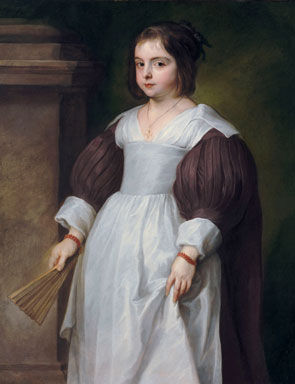Valuable Van Dyck Painting Recently Re-Discovered by Art Connoisseur Philip Mould
Painstaking research began before the sale to piece together the painting’s history.
LONDON.- Treasured by 19th century connoisseurs, prided by the Rothschild’s, snatched by the Nazis, and subsequently lost behind layers of dirt, a hugely valuable Van Dyck painting recently re-discovered in a Parisian auction house will go on display to the public in the UK for the first time this Wednesday. It will be the centrepiece of an exhibition called Finding Van Dyck. which will run from 15 June - 13 July at Philip Mould Fine Paintings, 29 Dover Street, London, W1. Admission is free.
Van Dyck’s rediscovered work A Portrait of a Young Girl first caught the eye of fine art connoisseur, broadcaster and author Philip Mould OBE when he and his co-director, Dr. Bendor Grosvenor, were flicking through a Christie’s catalogue for a Parisian house sale of the Rothschild banking family last autumn. The picture was called simply ‘Flemish School’ and it had an estimate of 15,000-20,000 Euros.
Painstaking research began before the sale to piece together the painting’s history. In the few weeks available Bendor Grosvenor managed to establish that it had, in fact, been sold by Christie’s before as a Van Dyck and had passed through the hands of many notable owners, including Prince Talleyrand, Napoleon’s foreign minister.
Other former owners included Emmerich Joseph, Duc Dalberg (1773-1833), a prominent German diplomat who served under Napoleon and later Louis XVIII, and Lord Charles Townshend, who paid £200 for it when it was sold to him in 1831 by a leading 19th century art dealer John Smith from Talleyrand’s collection. Later that century it came into the possession of the Rothschild family but was stolen from them by the Nazis in the Second World War. It was restituted in 1946.
However, when Mould and Grosvenor spotted the painting, listed among umbrella stands and drinks trolleys in Christie’s September 2010 catalogue, it was simply described as Flemish School, 17th Century, Portrait of a young girl with a fan. The only other information given was that the picture had previously been identified as Princess Henriette of France.
Mould was immediately able to rule out the previous identification of the sitter. Henrietta Maria of France, wife of Charles I, was born in 1609, and would have been too old to appear in the portrait, which dates to 1630-34.
“What I was certain of however was that beneath the dirt – what I surmised was half a century of cigar and cigarette smoke generated at the Rothschild’s Parisian soirees – lay a genuine masterpiece,” said Philip Mould.
Fighting off strong competition for the painting he eventually secured the portrait for €1,017,000 – fifty times its upper estimate.
“Cleaning dramatically revealed its former glory – including previously obscured details, such as the ribbon in the girl’s hair and the usual range of colours, glazes and half tones one would expect to see in a Van Dyck,” added Philip Mould.
The portrait, which is now accepted as a genuine work, has more than tripled in value.
In the exhibition Finding Van Dyck, Mould and Grosvenor will share some of the secrets of tracking down lost paintings. Other recently discovered works by Van Dyck will be on view, including Portrait of A Lady in a White Dress on loan from the Bowes Museum, County Durham. The portrait was previously thought to be a 19th Century copy. Also on display will be an important preparatory study by Van Dyck, Study for the head of St Joseph, which was acquired as ‘Circle of Van Dyck’ in Christie’s secondary saleroom in South Kensington, London.
The exhibition will be open from 15th June to 13th July, Mon-Fri 10am-5pm, Sat 12pm-4pm. Entry is free.

/https%3A%2F%2Fprofilepics.canalblog.com%2Fprofilepics%2F1%2F0%2F100183.jpg)
/https%3A%2F%2Fstorage.canalblog.com%2F03%2F02%2F119589%2F96711876_o.jpg)
/https%3A%2F%2Fstorage.canalblog.com%2F11%2F31%2F119589%2F94773502_o.jpg)
/https%3A%2F%2Fstorage.canalblog.com%2F20%2F83%2F119589%2F94772815_o.jpg)
/https%3A%2F%2Fstorage.canalblog.com%2F26%2F72%2F119589%2F75604929_o.jpg)
/https%3A%2F%2Fstorage.canalblog.com%2F59%2F60%2F119589%2F26458628_o.jpg)



/http%3A%2F%2Fstorage.canalblog.com%2F25%2F19%2F119589%2F35531248_o.jpg)
/http%3A%2F%2Fstorage.canalblog.com%2F91%2F92%2F119589%2F34354939_o.jpg)
/http%3A%2F%2Fstorage.canalblog.com%2F16%2F73%2F119589%2F31468535_o.jpg)
/http%3A%2F%2Fstorage.canalblog.com%2F38%2F17%2F119589%2F31007050_o.jpg)